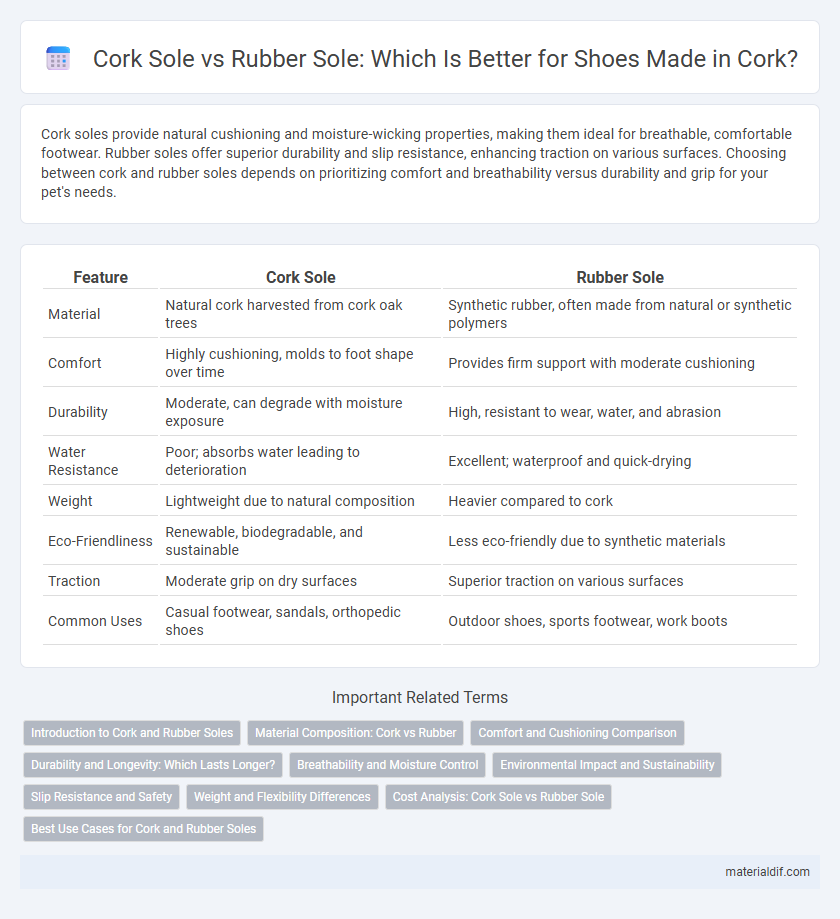Cork soles provide natural cushioning and moisture-wicking properties, making them ideal for breathable, comfortable footwear. Rubber soles offer superior durability and slip resistance, enhancing traction on various surfaces. Choosing between cork and rubber soles depends on prioritizing comfort and breathability versus durability and grip for your pet's needs.
Table of Comparison
| Feature | Cork Sole | Rubber Sole |
|---|---|---|
| Material | Natural cork harvested from cork oak trees | Synthetic rubber, often made from natural or synthetic polymers |
| Comfort | Highly cushioning, molds to foot shape over time | Provides firm support with moderate cushioning |
| Durability | Moderate, can degrade with moisture exposure | High, resistant to wear, water, and abrasion |
| Water Resistance | Poor; absorbs water leading to deterioration | Excellent; waterproof and quick-drying |
| Weight | Lightweight due to natural composition | Heavier compared to cork |
| Eco-Friendliness | Renewable, biodegradable, and sustainable | Less eco-friendly due to synthetic materials |
| Traction | Moderate grip on dry surfaces | Superior traction on various surfaces |
| Common Uses | Casual footwear, sandals, orthopedic shoes | Outdoor shoes, sports footwear, work boots |
Introduction to Cork and Rubber Soles
Cork soles offer natural cushioning, moisture-wicking properties, and eco-friendly benefits derived from the bark of cork oak trees, making them lightweight and breathable. Rubber soles provide durable traction, water resistance, and shock absorption, commonly used in various footwear for enhanced grip and longevity on different surfaces. Both sole types cater to different needs, with cork prioritizing comfort and sustainability, while rubber emphasizes durability and performance.
Material Composition: Cork vs Rubber
Cork soles are made from natural bark harvested primarily from the cork oak tree, offering lightweight, breathable, and environmentally sustainable footwear options. Rubber soles, composed of synthetic or natural rubber compounds, provide superior durability, water resistance, and enhanced grip on various surfaces. The choice between cork and rubber soles hinges on prioritizing eco-friendliness and comfort versus robust performance and moisture protection.
Comfort and Cushioning Comparison
Cork soles offer superior comfort and cushioning due to their natural shock-absorbing properties and ability to mold to the foot's shape over time, providing personalized support. Rubber soles deliver excellent durability and impact resistance, maintaining consistent cushioning across various terrains. In Cork, choosing cork soles enhances long-term comfort for daily walking, while rubber soles prioritize resilience and grip for active outdoor use.
Durability and Longevity: Which Lasts Longer?
Cork soles offer natural shock absorption and mold to the shape of the foot over time, but they are prone to wear and moisture damage, limiting their durability compared to rubber soles. Rubber soles provide superior resistance to abrasion, water, and environmental factors, resulting in a longer lifespan and consistent performance. For footwear with frequent outdoor use, rubber soles generally last significantly longer than cork soles due to their robust material properties.
Breathability and Moisture Control
Cork soles offer excellent breathability and natural moisture-wicking properties due to their porous cellular structure, which helps keep feet dry and comfortable. Rubber soles, while more durable and water-resistant, lack the same level of breathability and can trap moisture, leading to potential discomfort. Choosing cork soles enhances airflow and moisture control, making them ideal for those seeking natural foot ventilation.
Environmental Impact and Sustainability
Cork soles offer superior environmental benefits compared to rubber soles, as cork is a renewable, biodegradable material harvested from the sustainably managed cork oak forests primarily in the Mediterranean region. Rubber soles, often derived from synthetic sources or non-sustainably harvested natural rubber, contribute to deforestation and produce greater carbon emissions during production and disposal. Cork soles also require less energy to manufacture and naturally decompose without releasing harmful pollutants, making them a more sustainable choice in footwear design.
Slip Resistance and Safety
Cork soles provide natural slip resistance due to their textured surface and moisture-wicking properties, making them suitable for dry conditions but less effective on wet or oily floors. Rubber soles excel in slip resistance and safety with enhanced grip and durability, especially on slippery surfaces, reducing the risk of falls. For environments requiring maximum protection against slips, rubber soles are the preferred choice over cork.
Weight and Flexibility Differences
Cork soles are significantly lighter than rubber soles, providing enhanced comfort and reducing foot fatigue during extended wear. Cork offers superior flexibility, molding naturally to the foot's shape, which improves overall movement and support. Rubber soles, although heavier, provide increased durability and better shock absorption but lack the lightweight and adaptive properties of cork.
Cost Analysis: Cork Sole vs Rubber Sole
Cork soles typically cost more upfront due to their natural harvesting and processing methods, but they offer superior durability and comfort that can lead to long-term savings. Rubber soles are generally less expensive initially and provide excellent water resistance and flexibility, making them cost-effective for quick replacements. When analyzing overall value, cork soles often justify their higher price through extended lifespan and enhanced foot support compared to rubber alternatives.
Best Use Cases for Cork and Rubber Soles
Cork soles offer exceptional cushioning and moisture-wicking properties, making them ideal for casual footwear, sandals, and eco-friendly shoes used in dry, warm conditions. Rubber soles provide superior durability, slip resistance, and shock absorption, making them best suited for athletic shoes, work boots, and outdoor footwear in wet or rugged environments. Choosing between cork and rubber soles depends on the need for comfort and breathability versus traction and toughness.
Cork Sole vs Rubber Sole Infographic

 materialdif.com
materialdif.com